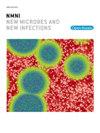The emergence of oropouche fever: A potential new threat?
IF 5.4
Q2 INFECTIOUS DISEASES
引用次数: 0
Abstract
Oropouche fever, caused by the Oropouche virus (OROV), has become a significant public health concern. Recent outbreaks highlight its increasing global spread, driven by environmental, social, and ecological factors. The disease presents clinical similarities to other arboviral infections, making accurate diagnosis essential for effective management and prevention. This article examines the epidemiological patterns of Oropouche fever, including its geographic distribution and outbreak drivers. It explores the clinical manifestations of the disease, focusing on common symptoms, complications such as fatal cases and fetal abnormalities, and the necessity of differential diagnosis. The pathophysiology of OROV infection is analyzed, detailing viral entry mechanisms, immune responses, and the role of vectors in transmission. Additionally, we assess diagnostic challenges, comparing serological and molecular methods while identifying their limitations. Therapeutic strategies are also reviewed, including symptomatic treatments and potential antiviral candidates. Findings indicate that OROV infections mimic other arboviral diseases, complicating clinical diagnosis. Current diagnostic tools have limitations in accuracy and accessibility, particularly in resource-limited settings. Symptomatic treatment remains the primary approach, as no specific antiviral therapies or vaccines exist. The study identifies gaps in diagnostic development, vaccine research, and public health surveillance. Oropouche fever threatens global health, necessitating improved surveillance, diagnostic tools, and targeted research efforts. Enhancing epidemiological studies and developing effective vaccines will mitigate its impact. Strengthening public health strategies can help control the spread of OROV and reduce its burden on affected populations.

口腔热的出现:一个潜在的新威胁?
由奥罗波切病毒(OROV)引起的奥罗波切热已成为一个重大的公共卫生问题。最近的疫情突出表明,在环境、社会和生态因素的推动下,其全球传播日益扩大。该病与其他虫媒病毒感染具有临床相似性,因此准确诊断对有效管理和预防至关重要。本文探讨了欧罗波切热的流行病学模式,包括其地理分布和暴发驱动因素。它探讨了疾病的临床表现,重点是常见症状,致命病例和胎儿异常等并发症,以及鉴别诊断的必要性。分析了OROV感染的病理生理学,详细介绍了病毒进入机制、免疫反应和媒介在传播中的作用。此外,我们评估诊断挑战,比较血清学和分子方法,同时确定其局限性。治疗策略也进行了回顾,包括对症治疗和潜在的抗病毒候选药物。结果表明,OROV感染与其他虫媒病毒性疾病相似,使临床诊断复杂化。目前的诊断工具在准确性和可及性方面存在局限性,特别是在资源有限的情况下。对症治疗仍然是主要的方法,因为没有特定的抗病毒治疗或疫苗。这项研究确定了诊断发展、疫苗研究和公共卫生监测方面的差距。Oropouche热威胁着全球健康,需要改进监测、诊断工具和有针对性的研究工作。加强流行病学研究和开发有效的疫苗将减轻其影响。加强公共卫生战略可以帮助控制口腔感染的传播并减轻其对受影响人群的负担。
本文章由计算机程序翻译,如有差异,请以英文原文为准。
求助全文
约1分钟内获得全文
求助全文
来源期刊

New Microbes and New Infections
Medicine-Infectious Diseases
CiteScore
10.00
自引率
2.50%
发文量
91
审稿时长
114 days
 求助内容:
求助内容: 应助结果提醒方式:
应助结果提醒方式:


